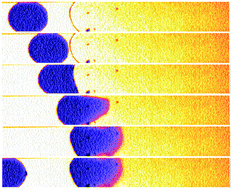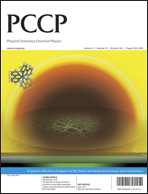Optimisation of a microfluidic analysis chamber for the placement of microelectrodes†
Abstract
The behaviour of droplets entering a microfluidic chamber designed to house microelectrode detectors for real time analysis of clinical microdialysate is described. We have designed an analysis chamber to collect the droplets produced by multiphase flows of oil and artificial cerebral spinal fluid. The coalescence chamber creates a constant aqueous environment ideal for the placement of microelectrodes avoiding the contamination of the microelectrode surface by oil. A stream of alternating light and dark coloured droplets were filmed as they passed through the chamber using a high speed camera. Image analysis of these videos shows the colour change evolution at each point along the chamber length. The flow in the chamber was simulated using the general solution for Poiseuille flow in a rectangular chamber. It is shown that on the centre line the velocity profile is very close to parabolic, and an expression is presented for the ratio between this centre line velocity and the mean flow velocity as a function of channel aspect ratio. If this aspect ratio of width/height is 2, the ratio of flow velocities closely matches that of Poiseuille flow in a circular tube, with implications for connections between microfluidic channels and connection tubing. The droplets are well mixed as the surface tension at the interface with the oil dominates the viscous forces. However once the droplet coalesces with the solution held in the chamber, the no-slip condition at the walls allows Poiseuille flow to take over. The meniscus at the back of the droplet continues to mix the droplet and acts as a piston until the meniscus stops moving. We have found that the no-slip conditions at the walls of the chamber, create a banding effect which records the history of previous drops. The optimal position for sensors is to be placed at the plane of droplet coalescence ideally at the centre of the channel, where there is an abrupt concentration change leading to a response time ≪16 ms, the compressed frame rate of the video. Further away from this point the response time and sensitivity decrease due to convective dispersion.

- This article is part of the themed collection: Interfacial processes and mechanisms

 Please wait while we load your content...
Please wait while we load your content...